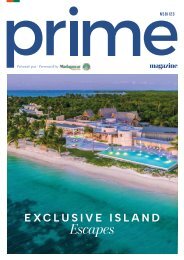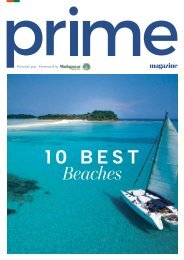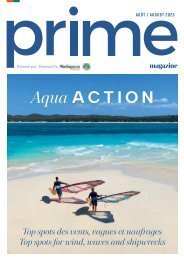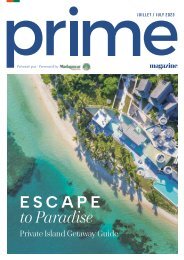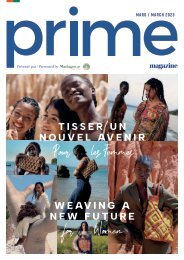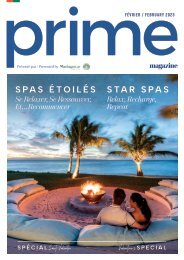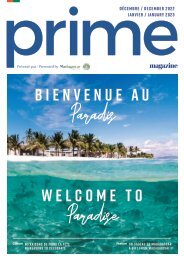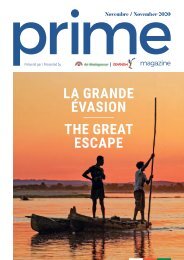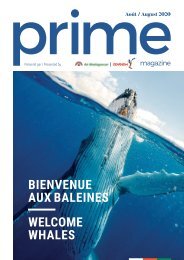Prime Magazine March 2020
You also want an ePaper? Increase the reach of your titles
YUMPU automatically turns print PDFs into web optimized ePapers that Google loves.
FEATURE<br />
ANTESAKA<br />
Ceux qui viennent des Sakalava. Ils sont surtout regroupés<br />
dans le sud de la côte Est dans la province de Fianarantsoa.<br />
D'après l’histoire, Andriamandresy, un prince sakalava,<br />
quitta la région du Bas-Mangoky et s’installa sur les rives de<br />
Mananara. Il y constitua un nouveau royaume, les Antaisaka<br />
(venant de Antaisakalava).<br />
The ones from the Sakalava. They are mostly grouped in the<br />
south of the east coast in the province of Fianarantsoa.<br />
According to the story, Andriamandresy, a Sakalava prince,<br />
left the lower Mangoky region and settled on the shores<br />
of Mananara. There he established a new kingdom, the<br />
Antaisaka (from Antaisakalava).<br />
ANTANOSY<br />
Ceux de l’île. Ce peuple est centré autour de la ville de<br />
Tolagnaro (Fort-Dauphin).<br />
BARA<br />
Cette ethnie est composée de pasteurs nomades. Ils<br />
occupent le territoire Bara, un coin reculé et désertique<br />
composé de paysages de prairie et de palmiers Satrana<br />
et ornementé de troupeaux de zébus.<br />
This ethnic group is composed of nomadic pastors. They<br />
occupy the Bara territory, a remote and desert corner<br />
composed of meadow landscapes and Satrana palms with<br />
herds of zebus.<br />
ANTAKARANA<br />
Ceux qui peuplent la montagne rocheuse. A l’extrême<br />
nord d’Ambilobe au Cap d’Ambre, les Antakarana sont<br />
établis dans le massif de l’Antakarana, dans la région<br />
d’Antsiranana. Ils seraient originaires d’une branche<br />
Sakalava qui aurait occupée l’extrême nord de la Grande<br />
Île au XVIIème siècle.<br />
The ones on the island. These people are centred around the<br />
town of Tolagnaro (Fort-Dauphin).<br />
ANTANDROY<br />
Ceux des épines. Comme leur nom l’indique, ils peuplent<br />
la région Androy, la région la plus sèche de Madagascar,<br />
à l’extrémité sud. Ces peuples sont les descendants de<br />
valeureux guerriers et leur courage demeure légendaire.<br />
Those of the thorns. As their name indicates, they populate<br />
the Androy region, the driest region of Madagascar, at the<br />
southern end. These peoples are the descendants of valiant<br />
warriors and their courage remains legendary.<br />
MERINA<br />
Ceux du pays élevé. Ils occupent la région d’Antananarivo,<br />
appelée Imerina. D’origine indonésienne et malaisienne, ils<br />
résident au centre de Madagascar. Ce fut le roi Andrianjaka<br />
qui choisit Antananarivo comme capitale du royaume et le<br />
roi Ralambo (1575-1610) qui baptisa son royaume « Imerina<br />
Ambaniandro »<br />
Those of the high land. They occupy the region of Antananarivo,<br />
called Imerina. Of Indonesian and Malaysian origin, they live in<br />
the centre of Madagascar. It was King Andrianjaka who chose<br />
Antananarivo as the capital of the kingdom and King Ralambo<br />
(1575-1610) who named his kingdom 'Imerina Ambaniandro'.<br />
BETSILEO<br />
Les nombreux invincibles. L'histoire du peuple Betsileo est,<br />
comme son nom l’indique, une histoire de conquêtes. Leur<br />
région est située plus au sud de l’Imerina (Fianarantsoa). Ce<br />
sont d’excellents riziculteurs et artisans du bois.<br />
The many invincible. The history of the Betsileo people is, as<br />
their name suggests, a history of conquests. Their region is<br />
located further south of Imerina (Fianarantsoa). They are<br />
excellent rice farmers and wood craftsmen.<br />
Those who populate the rocky mountain. At the extreme<br />
north of Ambilobe at Cap d'Ambre, the Antakarana<br />
people are settled in the Antakarana massif, in the region<br />
of Antsiranana. They are said to originate from a Sakalava<br />
branch that would have occupied the extreme north of<br />
the Big Island in the 17th century.<br />
SAKALAVA<br />
Ceux des longues vallées. Le peuple Sakalava occupe un<br />
vaste territoire dans la région ouest de Madagascar. Leur<br />
nom signifie en réalité Le long pays de Saka. La province<br />
d’Isaka (d’où vient le mot Saka) est située sur la côte sudest<br />
de la Grande Île, d’où étaient issues les principales<br />
familles Sakalava.<br />
Those of the long valleys. The Sakalava people occupy a<br />
vast territory in the western region of Madagascar. Their<br />
name actually means 'the long land of Saka'. The province<br />
of Isaka (where the word Saka comes from) is located on<br />
the south-east coast of the Big Island, where the main<br />
Sakalava families originate.<br />
VEZO<br />
Pagayeurs. Peuple descendant des Sakalava de Menabe,<br />
les Vezo habitent le sud-ouest de Madagascar, de<br />
Morombe à Tuléar. Ce sont d'excellents pêcheurs et ils<br />
ne pratiquent pas la circoncision. On distingue d’une<br />
part les Hoimalagny ou Vezon-driaka (Vezo de la mer)<br />
et d’autre part les Antimangaro ou Vezompotaka (Vezo<br />
des vases).<br />
Paddlers. The Vezo, a people descended from the<br />
Sakalava of Menabe, live in south-western Madagascar,<br />
from Morombe to Tulear. They are excellent fishermen<br />
and do not practise circumcision. We distinguish on<br />
the one hand the Hoimalagny or Vezon-driaka (Vezo<br />
of the sea) and on the other hand the Antimangaro or<br />
Vezompotaka (Vezo of the vases).<br />
© : ONTM / ORT DS / Dominique BRUYNEEL / Rémi Pinaton / Serge Marizy<br />
<strong>Magazine</strong> online<br />
www.primemedia.international<br />
| 71 |



